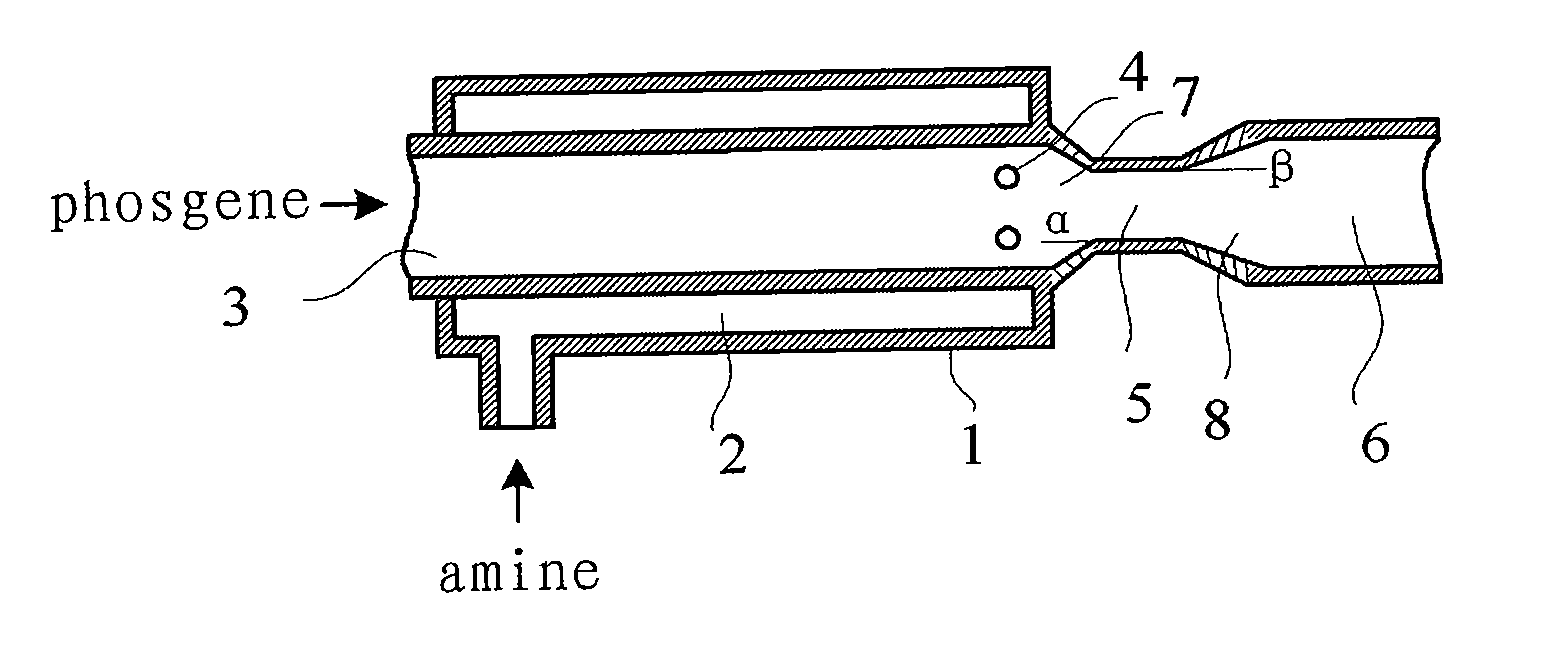Hole jet reactor and a process for the preparation of an isocyanate using the reactor
a technology of isocyanate and reactor, which is applied in the preparation of isocyanic acid derivatives, gas-gas reaction processes, separation processes, etc., can solve the problems of obstructing gas flow, obstructing channel, and requiring considerable safety precautions in the reactor, so as to improve the mixing effect, reduce the kinetic energy of the reaction materials, and accelerate the reaction rate
- Summary
- Abstract
- Description
- Claims
- Application Information
AI Technical Summary
Benefits of technology
Problems solved by technology
Method used
Image
Examples
example 1
[0042]Phosgene, heated to 360° C., flowed continuously into the reaction tube at a rate of 12 m / s through the internal feed tube. At the same time, a mixture, heated to 360° C., of 4,4′-diaminodicyclohexylmethane (H12MDA) and nitrogen was jetted at the rate of about 42 m / s into the phosgene stream through 6 holes made in the wall of the internal feed tube. The mole ratio of H12MDA:phosgene:nitrogen was 1:6:1. The jetting directions of the holes were all perpendicularly aimed at the axis of the internal feed tube, i.e. the center of the phosgene stream flow. The diameter of each of the holes was 1 mm; the internal feed tube was measured 8 mm in inner diameter and 2 mm in wall thickness; the inner diameter of the external feed tube was 16 mm (the thickness of the annular space was 2 mm); the necking tube was measured 5 mm in inner diameter and 20 mm in length; and the pressure inside the reaction tube was 400 mbar. The reactor was connected at the downstream part thereof with an isocy...
example 2
[0043]Phosgene, heated to 360° C., flowed continuously into the reaction tube at the rate of 8 m / s through the internal feed tube. At the same time, a mixture, heated to 360° C., of H12MDA and nitrogen was jetted at the rate of about 25 m / s into the phosgene stream through 4 holes made in the wall of the internal feed tube. The mole ratio of H12MDA:phosgene:nitrogen was 1:6:1. The diameter of each of the holes was 2 mm; the internal feed tube was measured 12 mm in inner diameter and 2 mm in wall thickness; the inner diameter of the external feed tube was 18 mm; the necking tube was measured 5 mm in inner diameter and 20 mm in length; and the pressure inside the reaction tube was 400 mbar. The vapors emerging from the reaction tube of the reactor were condensed and separated under the process conditions of Example 1. The yield of H12MDI was 97.6% of the theory.
example 3
[0045]Isophoronediamine (IPDA) was reacted with phosgene under the same process conditions of Example 1. The mole ratio of IPDA:phosgene:nitrogen was 1:6:1. The reactor was the same as that in Example 1. Before entering the reactor, phosgene and a mixture of IPDA and nitrogen were separately preheated to 310° C. The yield of IPDI was 98.6% of the theory.
PUM
| Property | Measurement | Unit |
|---|---|---|
| distance | aaaaa | aaaaa |
| angle | aaaaa | aaaaa |
| velocity | aaaaa | aaaaa |
Abstract
Description
Claims
Application Information
 Login to View More
Login to View More - R&D
- Intellectual Property
- Life Sciences
- Materials
- Tech Scout
- Unparalleled Data Quality
- Higher Quality Content
- 60% Fewer Hallucinations
Browse by: Latest US Patents, China's latest patents, Technical Efficacy Thesaurus, Application Domain, Technology Topic, Popular Technical Reports.
© 2025 PatSnap. All rights reserved.Legal|Privacy policy|Modern Slavery Act Transparency Statement|Sitemap|About US| Contact US: help@patsnap.com


